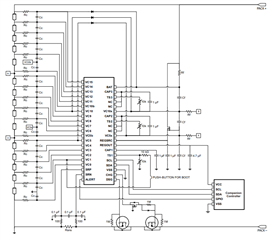Other Parts Discussed in Thread: BQ769200, BQ76200, BQ76920, BQ76930, BQ78350-R1A, BQ76952, BQ78350
I am designing a battery management system for a Li-ion battery pack for which I have shortlisted BQ76940 IC.
When I went over the Typical application schematic in the data sheet, there is a bidirectional MOSFET pair on the lowside. Also there is a P channel MOSFET at the gate of CHG MOSFET. Can you explain how these function? I have marked them in the schematic.

I also read that to drive the MOSFETs in the high side, we need to implement gate drivers. How important is this? The BMS will be managing a 48V, 60Ah battery.
Also the BQ769200 high side N channel FET driver doesn't seem to be available. Is there any alternative to it?


